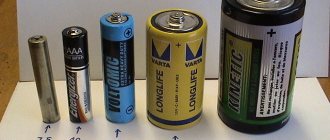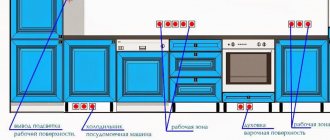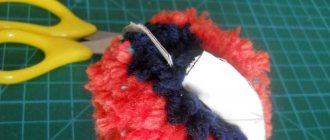The first paper stapler was made in the 18th century for the French Emperor Louis XV. Each staple was marked with the sign of the royal court.
In 1867, D. McGill received a patent for a press that made it possible to fasten sheets using brass fixtures.
His device became the basis for modern stitchers. Modern devices are smaller and lighter. They are much more convenient to use.
Many people forget
Before work, adjust the adjusting screw according to the material of the surface you are going to work with.
If it is hard plywood, strong penetration of the material will be required, therefore, it is worth setting a high force. If it is a loose surface, the force must be reduced so as not to break through the fabric, or for example the PVC panel that you are shooting.
During operation, it is recommended to press the lever with one hand and press the adjusting screw with the thumb of the other hand. Then the recoil will be minimal and the load will be distributed evenly in the stapler. You will be able to nail the brackets much better.
Possible mistakes
There are several of the most common, frequently encountered errors and problems that accompany the operation of a furniture stapler. The tool may fire multiple staples at once, or not at all, and may damage upholstery material. Errors are due to the following reasons:
- incorrect pre-adjustment of the adjusting screw when performing work with traditional mechanical models of the device;
- neglect of the rule of advance marking of places for installing staples, which allows for high-quality and uniform tension of upholstery material;
- lack of fixation of the upholstery with a free hand in order to prevent the material from moving during operation with a stapler.
It is important to control the number of staples inside the “magazine” of the tool, and also be sure to secure the handle with a safety lock immediately after finishing work. This will prevent spontaneous or accidental shooting.
It is strictly forbidden to work with a faulty tool. If necessary, the problem is diagnosed, and the firing pin that has exhausted its life is also periodically replaced.
How to insert staples into the receiver
The design of all mechanical hammers is almost the same. There is a handle-lever, due to which pressing occurs, and at the bottom of the stapler there is a metal plate that opens the receiver. This is where we have to load the staples.
Before you buy brackets at a hardware store, you need to find out what size will fit your device. As a rule, the size and type of suitable staples are indicated on its body.
For example, the body of our stapler indicates a width of 12 mm and a depth of 6-14 mm. This means that you will only be able to charge staples in this range.
Smaller or larger brackets will not fit into the receiver. The size of the staples in millimeters is also indicated on their packaging.
To insert projectiles into the stapler, you need to open the metal plate on the back surface.
To do this, you need to take it with your thumb and forefinger on both sides, then pull it towards you and slightly down. Thus, we press the metal tab on the back surface of the plate, and pull out a metal spring, similar to the one found in a regular office stapler.
If there are any staples left in your stapler, they will fall out once the spring is pulled out. If they are not there, then it’s time to install new ones for further work.
The staples are inserted into the receiver (the hole is in the “P” position). Next, insert the spring back, closing the metal tab. That's all, the tool is loaded and ready to go!
What to do if a bracket gets stuck
It is worth noting another very important point that will help you in your work. It happens that the staples become bent and get stuck in the exit hole. They cannot be hammered into the surface and cannot be pulled out by hand.
In this case, we will need to pull out the feed magazine completely.
This option exists for almost all professional staplers.
First you will have to repeat the opening of the metal plate and pull out the spring.
Next, in the middle of the lower part of the stapler you need to find an iron part, slightly protruding from both sides. Grasp it tightly with your thumb and forefinger on both sides and pull down forcefully.
This will remove the entire feed magazine that was in the tool.
You will see a jammed staple that can now be easily pulled out by hand.
Putting the stapler back together is not difficult: the entire pulled out block returns to its place with a press. You should hear a click when you do this. Afterwards, do not forget to replace the spring.
Not just parentheses
Some staplers can work not only with staples, but also with studs of various shapes. The designations of what the stapler works with are indicated on its body or in the instructions.
I tuck the nails into the stapler in the same way as with staples, but you need to be careful after pulling out the spring. A row of nails must be loaded along one of the outer edges of the letter “P”, and not inside this very letter!
If you want it to produce two nails side by side when working with a stapler, load the second row along the second outer edge. Next, the spring is inserted and the stapler is closed.
The first paper stapler was made in the 18th century for the French Emperor Louis XV. Each staple was marked with the sign of the royal court.
In 1867, D. McGill received a patent for a press that made it possible to fasten sheets using brass fixtures.
His device became the basis for modern stitchers. Modern devices are smaller and lighter. They are much more convenient to use.
How to load a stapler with staples
The first paper stapler was made in the 18th century for the French Emperor Louis XV. Each staple was marked with the sign of the royal court.
In 1867, D. McGill received a patent for a press that made it possible to fasten sheets using brass fixtures.
His device became the basis for modern stitchers. Modern devices are smaller and lighter. They are much more convenient to use.
Types of staplers
In 1997, the stapleless stapler was invented. This stapler binds sheets together with small strips cut from paper. Therefore, its owner does not have a question about how to charge the stapler. There are three types of staplers: standard, mini and construction.
They are equipped with a manual or electric drive. A stationery stapler is used to staple paper sheets with metal staples. It is used to make brochures and notebooks. A regular stapler staples up to 50 sheets. One pack contains 20 plates of 50 staples. When you press the handle of the device, the spring, which is located inside, is tensioned and released, driving in the bracket. It passes through the paper and hits a deflection plate, which bends its ends. Some stapler models bend staples in two different ways: inward or outward. In the second case, the bracket is easily pulled out. This stitching method is used to temporarily secure sheets. Some models have a tab on the back for removing staples. They are also equipped with a mechanical amplifier. The best material for a stapler is metal coated with plastic. To prevent the device from scratching the surface of the table, plastic or rubber pads are placed on its bottom.
Types of furniture staplers
The correct choice of a furniture stapler is based on determining the frequency and duration of use, the type of surfaces to be connected. Considering these factors, you can purchase one of three types of staplers in the store:
- Manual or mechanical tacker
, which works thanks to the physical effort of the master. The tool has a simple design and the lowest price. - An electric furniture stapler gun
is similar to the mechanical version, but the spring is driven by an electric current. - Pneumatic tools
are used by professionals when carrying out repairs or making furniture. Its design differs significantly from analogues, which increases productivity and price.
Manual furniture stapler
The simplest and most often used in everyday life is a manual stapler for furniture. Its power is enough to independently reupholster sofas, chairs and armchairs in the house, carry out minor repairs or manufacture interior items. The main part of the impact mechanism in a manual staple gun is the impact spring, which can be:
- Twisted
. It is installed in the most budget models and is considered less productive than its analogues. You can determine the presence of a coil spring by the presence of an adjusting screw on the device body. - Spring
. This type of furniture stapler has greater performance and durability. The recoil in it is significantly less than that of the previous model. - Lamellar
. This mechanism is used in professional devices due to its high performance and price.
Read also: Smooth start of an angle grinder with your own hands
How to load a stapler with staples?
Before filling the stapler, you need to make sure that the selected staples are the right size for it. Manufacturers indicate their size on the device packaging. For convenience, they are marked with numbers. How to charge the stapler? Most models open from the top. In some cases, you may need to remove the side fasteners before opening. Other staplers open with the press of a button. The opening method is indicated in the user manual.
How to load a stapler with staples? They are placed in the compartment so that their ends fit into the slots. You can use tweezers to thread the mini stapler. The stapler is then closed. At the same time, a characteristic click should be heard. The stapler is checked by fastening a stack of sheets of paper. If staples bend and get stuck inside, you will need to open the stapler and straighten the rows of staples.
Construction stapler
How to charge the stapler? First you need to make sure that the stapler is locked. Then you need to find the button that opens the tray. It is usually located on the back of the device. How to charge the stapler? The staple holder is removed from the device. The remaining staples are thrown away. The stapler is cleaned of dust and debris. Then it is turned over and the staples are inserted into it upside down.
A furniture stapler is a fairly universal tool with which you can not only perform furniture upholstery procedures, but also a number of other construction operations.
Today, there are several types of similar equipment, differing in their operating principles:
Pneumatic staplers are used in industry, and electric and manual staplers are used in everyday life. Models belonging to the latter type are the most common in the furniture industry due to their mobility and ease of use. Let’s use this example to look at the principle of operation, operation and repair of furniture staplers.
However, before moving on to this procedure, I would like to say a few words about staples and their varieties.
How to use it correctly
Despite the apparent simplicity of design, working with a furniture stapler requires compliance with a number of rules. Today, several of the most popular and very easy-to-use modifications of the tool are produced (pneumatic and manual types, electric models), but the technology for their use is in most cases common.
The main stages of working with a furniture stapler:
- Move the spring and fill the tool with staples through a special groove.
- Return the spring to its original place and check that the tool is ready for use.
- Press the tool firmly onto the location chosen for fixing the bracket.
- Press the special lever or trigger button.
The success of the “shot” fired is determined by the characteristic sound and the presence of a staple embedded in the upholstery material.
Characteristics and types of furniture brackets
The main indicator that is taken into account when choosing a bracket is its depth. Depending on the nature of the work performed, this indicator can vary from 4 to 14 millimeters.
So, for example, in order to carry out the procedure of upholstering furniture with fabric, a staple with a depth of 8 millimeters will be sufficient, while for fixing thicker materials, a staple with a greater depth should be selected.
Also, depending on the overall dimensions, staples are divided into the following types:
- 53 - is the most common. Staples of this type have a width of 11.4 millimeters and a thickness of 0.7 mm. The depth of this fastening element varies from 4 to 14 millimeters;
- 140 – having the following characteristics: width – 10.6 millimeters, thickness – 1.2 mm, depth – similar to the previous type;
- 36 – this marking means that the stapler can shoot staples that have a semicircular shape and are mainly used for cable installation;
- 300 - These are special nails intended only for the stapler.
When choosing a bracket, you should also take into account the structure of the material from which it is made.
Furniture stapler diagram
A manual construction stapler has a magazine into which a clip of staples or special nails is loaded. The bracket is hit by a firing pin, which is attached to the firing pin. The size of the striker in the tool depends on the dimensions of the consumables (staples) used. The hammer, in turn, touches the spring, the degree of compression of which is adjusted by a special screw. The shock is absorbed using a shock absorber located inside the stapler.
See the diagram for the device of the stapler:
A coiled mainspring is installed on inexpensive models.
A stapler with a leaf spring is more powerful and expensive.
Furniture stapler device
The device that hammers staples into the surface has several names: furniture or construction stapler, staple gun, staple gun, tacker and staple gun. All names are equally applicable in both written and oral speech. The tool is used to connect wood, plastic, film, plywood, insulation and fabric together with special staples or pins.
You can find several types of tacker in stores, but the general principle of how a furniture stapler works is the same for all models:
- All mechanisms are enclosed in a plastic or metal case.
- The main component is the impact mechanism, which consists of a spring, striker and striker.
- The shock absorber softens the recoil when firing.
- The fuse protects against accidental firing of the staple.
- The cocking handle or trigger is operated by physical force, electric current or compressed air force.
- Any furniture stapler, the characteristics of which can vary significantly, has a special magazine with staples. It is often made transparent so that the amount of consumables can be visually controlled.
- The ramming mechanism ensures the required entry of the pin into the surface.
- The tip makes it easy to adjust the accuracy of each shot.
- The impact force can be changed thanks to a special regulator, thereby adjusting the stapler to work with surfaces of different hardness.
How to use a stapler
Refueling
In order to load the stapler with staples (i.e. load the staple gun), you must first move away the spring intended for pressing them. The staples themselves are placed in a special groove, in which, in fact, they need to be placed. After this, the spring is put in place. The tool is completely ready for use.
Video: how to thread a stapler with staples
Now you know how to insert staples into a stapler, we can proceed directly to work.
Shot
In order to fix the necessary element, you should firmly attach the device to the place where you plan to hammer the bracket. After this, without lifting the device from the surface, you must press the trigger button (lever). If these manipulations are successful, you will hear a characteristic sound and see a staple inserted into the material.
Tips and tricks
In order to protect yourself when working with a construction stapler, you should follow some rules:
- If you use a mechanical model of the device, it is necessary to adjust the screw regulator. This operation should be performed on a piece of rough material by rotating the screw from minimum to maximum. If the staple goes in all the way from the first shot, you can start working on the “finishing” part. Otherwise, re-adjustment is required;
- In order to drive the staples at the same distance, you should first mark the necessary places with a pencil or ballpoint pen;
- Hold the material with your free hand so that when firing it does not move from the pre-designated place;
- Keep track of the number of staples in the “store” so as not to be left without a single fastening element at the most inopportune moment;
- After finishing work, secure the handle with the safety catch to prevent spontaneous or accidental firing.
The sequence of adjusting the stapler
Setting up a staple gun is needed in the following cases:
- after purchasing the tool before starting work;
- if the stapler stops completely driving in the fasteners;
- when starting to work with a material of a different density than the previous one.
If the stapler stops driving in the fasteners completely, this is due to gradual wear of the spring of the impact mechanism or its loosening. For some time, the adjustment will help, but after that you will need to purchase a new stapler.
Read also: How to ring a diode assembly
You should take into account the dimensions of the fasteners for which the tacker is designed: if the size of the staples exceeds what is allowed according to the operating instructions, then adjustment has nothing to do with it, you just need to select the appropriate consumables.
Mechanical staple guns with a coil spring have a screw that regulates the degree of compression . It is shown in the photo below with a red arrow.
If you tighten the adjusting screw clockwise, the spring will compress more strongly and its potential energy will increase. The result will be a blow of greater force. The ejected staple will go deeper into the surface of the material. Turning the adjuster counterclockwise will loosen the spring. The blow will also become weaker. By rotating the screw, you can adjust the stapler to work with material of varying hardness (density).
For mechanical models of staple guns with a spring (leaf) spring of the impact mechanism, the regulator is located under the handle. By rotating it in different directions, the force of the shot is adjusted. It is necessary to reconfigure the impact mechanism every time you start working with a different material. After adjusting the spring compression, it is recommended to test the tool's performance on a workpiece that is no longer needed.
The adjustment process ends when the fastener with the entire length of the legs enters the material without piercing it with the “back”. It is recommended to practice by rotating the adjuster from minimum to maximum spring compression.
Video review of staplers
You can also watch a short video on the review of furniture staplers, as well as the principle of filling, setting and working with them:
Good luck to all home craftsmen, if you have any questions - write!
The construction stapler gradually gained decent popularity as a tool for finishing work. This simple device has become indispensable for fastening roll materials , proving its effectiveness and versatility.
Currently, stores offer a wide range of staplers, and therefore it is necessary to choose the right tool, taking into account the actual conditions of its use.
How to use a furniture stapler: device, operation, tips
A furniture stapler is a fairly universal tool with which you can not only perform furniture upholstery procedures, but also a number of other construction operations.
Today, there are several types of similar equipment, differing in their operating principles:
Pneumatic staplers are used in industry, and electric and manual staplers are used in everyday life. Models belonging to the latter type are the most common in the furniture industry due to their mobility and ease of use. Let’s use this example to look at the principle of operation, operation and repair of furniture staplers.
However, before moving on to this procedure, I would like to say a few words about staples and their varieties.
What is a stapler?
A construction stapler (furniture stapler, stapler) is a hand-held tool for fastening various elements. According to the principle of operation, it differs little from a conventional office stapler, because in both cases, the fastened elements are connected with staples (usually U-shaped).
However, if a stationery tool pierces through the materials being joined and bends the ends of the staple, fixing the fastening, then its construction counterpart drives the ends of the staple into the base according to the principle of nails.
What is it needed for?
A construction stapler can be used for the following work:
- furniture upholstery - any type of fabric, leather, suede, microfiber, etc.;
- fixing insulation, vapor and waterproofing during installation of floors, walls, ceilings;
- attaching posters and photo wallpapers to walls and billboards;
- fixing back walls made of fiberboard, hardboard, plywood and other cast materials in cabinets;
- assembly of packaging structures, stitching of corrugated cardboard;
- installation of glazing beads on window frames;
- installation of tongue and groove boards on the floor and fastening of the floor covering;
- installation of greenhouses and greenhouses;
- fastening cables and wires;
- cladding with polymer boards and draping with fabric;
- other installation and finishing works.
Essentially, the stapler is designed to replace fastening methods such as hammering small nails and gluing.
It has the following advantages:
- large pressing area compared to nails, which increases the reliability of the connection;
- simplicity and accuracy of fastening, less likelihood of elements moving relative to each other when connected;
- acceleration of the process and mechanization of labor;
- possibility of use in hard-to-reach places;
- fastening of various elements, regardless of the material, which compares favorably with glue, which must be selected;
- versatility.
Which to choose?
Construction staplers are divided into several types according to certain parameters. For example, according to the principle of operation - mechanical, electric and pneumatic tools.
By purpose:
- Typical (classic) stapler. It usually uses U-shaped staples, but special nails can also be installed. It has a universal purpose.
- The cable stapler is capable of securing cables and wires with a diameter of up to 8-10 mm, for which rounded staples are used. Such fastening can be carried out in electrical networks with a voltage of no more than 50 V. At higher voltages it cannot be used due to the risk of a short circuit. The main purpose is telephone, computer, communication lines.
- The packaging tool is designed to work with cardboard (including corrugated cardboard) and various film materials. It resembles a stationery device, because... bends the ends of staples, but has significantly greater power and size.
- The window option is capable of securing glazing beads and other elements using metal pins. The length of these fasteners can range from 10 to 50 mm, depending on the principle of operation of the stapler.
- Thacker uses V-shaped staples. This fastener design allows you to connect workpieces located at an angle to each other. An example of use is assembling photo or painting frames.
- The rivet stapler (rivet gun) is capable of installing aluminum, copper and steel rivets.
- The staple hammer uses the inertial principle, i.e. it is used like a hammer, but the impact force is increased due to a special mechanism. The main purpose is installation of roofing and floor coverings.
According to technical characteristics:
- Impact force . This is an important criterion for choosing a tool, because it determines the depth of driving in the fastening element (staple, nail). For household construction, this parameter is in the range of 3-16 mm. Low-power tools work with staples up to 8 mm high, while higher-power tools work with staples higher than 10 mm.
- Bracket width . The area of pressing of the elements when they are fastened depends on this indicator, and therefore the speed of the operation and the reliability of the connection.
Design and principle of operation of a construction stapler
The furniture stapler is widely used by builders and furniture makers, as well as representatives of other fields of activity. Based on the type of energy used to fire a shot during operation, the following types of takers are distinguished:
- mechanical;
- electrical;
- pneumatic.
The first two types are intended for domestic use, while the last type of tool is considered professional and is used mainly when performing large-scale work. The operating principle of mechanical and electric staple guns is based on pushing out fasteners by the force of a cocked (compressed) spring. After pressing the trigger, it unclenches, which causes the striker to move. He strikes the staple (nail or pin), driving it into the surface of the material.
Read also: How to lubricate the gearbox of a bosch hammer drill
Mechanical stapler design
Manual (mechanical) staplers differ from their analogues in their simpler design. They consist of the following components and parts:
- cocking handle;
- a safety bracket that protects against accidental shots when transporting the tool;
- impact springs;
- shock absorber;
- drummer;
- striker;
- impact force regulator, providing the ability to work with material of varying degrees of hardness (different densities);
- housings;
- charging spring;
- store for fasteners;
- rammer (with spring and lock);
- tip that allows you to accurately drive fasteners.
The diagram of the staple gun device is shown in the photograph below.
The impact mechanism is the main unit of the stapler, cocked by the force of the worker’s muscles. It can be equipped with two types of springs:
Manufacturers indicate in the operating instructions for products the type of spring installed.
The twisted spring mechanism shown in the photo above is equipped with cheap models. They can be easily distinguished by the adjusting screw located on the tool body on the opposite side of the staple outlet hole. But it is also possible that the wing will be missing, then you will need to refer to the instructions to determine the type of spring installed.
Leaf springs are more powerful, but more expensive than their coiled counterparts. At the same time, the impact of a tool equipped with them during operation is less. They also have a long service life and are easier to cock. The leaf spring mechanism is installed on models intended for professional use.
To make it easier to work with the tool, the handle is covered with rubber pads, and the magazine is made with a transparent insert (which makes it easy to control the presence of staples or nails).
Design features of electric and pneumatic staplers
The device of a network-type electric stapler is shown in the photo below.
The numbers in the photograph correspond to the following structural elements:
- trigger;
- fuse;
- handle with special coating;
- power cord;
- on/off switch;
- shock force regulator;
- pusher mechanism;
- shop.
Inside the tool there are electric drive and impact mechanisms. In this case, the electric motor is designed to charge the spring.
Battery models do not have a power cord: batteries are installed instead.
The design of a pneumatic furniture stapler is more complex than its mechanical counterparts. Pneumatic tools consist of the following structural elements:
- housings;
- a cylinder with a piston located inside it;
- starting systems (trigger mechanism);
- magazine for fasteners with a pusher;
- impact mechanism;
- an inlet fitting designed to connect a high-pressure hose to the tool;
- regulator of penetration depth of fasteners (impact force);
- air distribution unit.
Pneumatic type scrapers are powered by the energy of compressed air supplied by a compressor or from a cylinder. After pressing the trigger, the gas passes through the air distribution unit. Next, the compressed air enters the cylinder, causing the piston to move. The latter transfers energy to the striker striking the fastener. After impact, the staple or nail is driven into the surface of the material.
Staples: types and sizes
When working with a construction stapler, it is important to choose the right staples for fastening specific elements. When choosing the most common consumables, you should adhere to the following recommendations :
- For fastening thin fabric, paper sheets, cardboard, U-shaped paper clips with a thickness of 0.7-0.75 mm, a width of 11.3 mm, and a height of 4-14 mm are suitable.
- For fiberboard, plastic, dense fabric - U-shaped staples 1.2 mm thick, 10.7 mm wide, height - from 6 to 14 mm.
- For installation of cables and wires - semicircular brackets model S with a thickness of 1.2 mm, width 4.5 mm, height 8-10 mm or model L of the same thickness, width 6 mm, height 10-15 mm.
In addition, when choosing brackets, it is necessary to take into account that they differ in the following characteristics :
- sharpened and unsharpened;
- in shape - with a narrow (for unnoticeable connection) and wide (increased reliability) back, as well as a flat shape for connecting non-woven films;
- according to the wire used for the manufacture - according to the thickness, diameter and stiffness of the wire and the size of the staple (the most common type is 53, among low-power tools - type 10 and 24, for professional use - type 140).
Useful videos
Types and applications, how to choose the right tool and brackets for it:
There is nothing easier after work to unload a construction manual stapler.
You just need to remove the persistent spring that presses the staples in the stapler, pressing the latch and removing it from the groove.
Simply shake out the remaining staples from the stapler and reinsert the tension spring.
Squeeze the handle, an idle blow will occur and place the safety hook on the handle of the stapler.
Everything can be put away for storage.
By the way, the stapler absolutely does not need to be discharged, it does not have any kinetic (accumulated energy), it works solely from squeezing the handle with your hand and does not pose any danger if it lies with staples inside (charged).
With electric or pneumatic staplers, a little more serious.
They need to be discharged, but before discharging, be sure to disconnect them from the mains or disconnect the compressor - check by pressing the trigger that the stapler is not working and only then discharge.
Manipulations are the same, open the bolt (spring-pressing brackets), shake out the brackets and return the bolt back.
I can’t speak for all models, but with absolute confidence I can tell you how to charge the construction stapler that I use myself. This is a tool from ZUBR (a solid tool, I tell you!) The design of the tray and staple feed mechanism of this stapler is slightly different from others. In order to charge the staples, you need to remove the entire sole along with the spring.
We turn the stapler over with the handle down, so that its working surface (sole) is facing up. On the back of the stapler, we see a chrome tongue that rises about a centimeter above the sole. We press it towards the sole, and without releasing it, we remove the entire staple feed block, in the backward direction. Having removed the block with the spring, without turning the stapler over, we place the block of staples in the formed trench closer to the front, with the “legs” up (during operation, they will be at the bottom). Insert the block back, squeezing the spring, until the tongue snaps into place. That's it - the stapler is loaded. All that remains is to cock it once by lowering the handle.
For greater clarity, I will provide a video -










